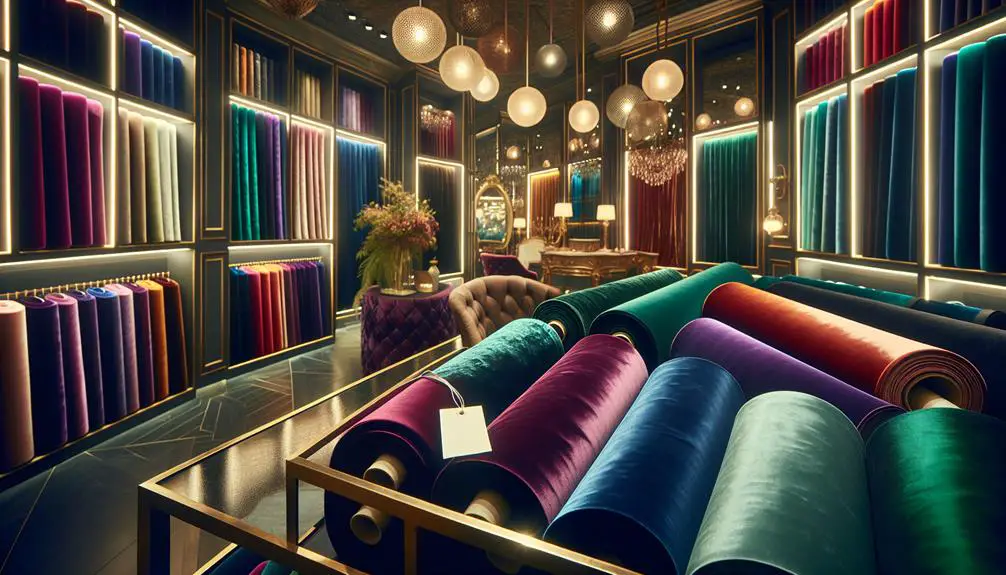So, I've been wondering about the real deal with velvet. It's always struck me as a bit of a luxury item, you know? You see it in high-end fashion, lush curtains, even upscale upholstery. But what makes real velvet, especially the silk kind, so pricey? It's not just about the posh look; there's a whole intricate process behind crafting it, which definitely ramps up its value. But that's not all there is to the story. I'm curious about how this affects its market price and alternatives like synthetic velvet. What do you think plays the biggest role in its cost?
Table of Contents
Key Takeaways
- Real velvet, particularly silk velvet, is expensive due to its luxurious quality and soft texture.
- The cost is influenced by labor-intensive traditional production methods.
- High taxes on luxury textiles further increase the price of real velvet.
- The material used, such as premium silk, significantly affects the overall cost.
- Production location impacts cost and quality, with stricter labor laws often leading to higher prices.
History of Velvet Fabric
Velvet's journey began in ancient civilizations, becoming a symbol of wealth and power through its intricate and luxurious weave. This fabric wasn't just cloth; it was a status marker, draped across nobles and kings to signify their high standing.
As I explore further, I see how the Renaissance influence really pushed velvet into the limelight. The period's emphatic love for art and beauty saw velvet become a favorite among the aristocracy in Europe. Artists depicted royalty clad in velvet robes, underlining its cultural symbolism as a fabric of the elite. It's fascinating how velvet wasn't just about aesthetics; it represented societal hierarchies and power structures.
Moving through history, every piece of velvet carried a story, a snippet of the cultural ethos of its time. This fabric's ability to absorb rich, deep dyes made it a preferred medium for expressing new artistic and fashion trends. It was more than just material; it was a canvas that reflected the evolving dynamics of wealth and class.
Understanding velvet's historical backdrop reveals why it's still revered and costly. It's not just fabric; it's centuries of art, power, and prestige woven together, and that's something you can't replicate cheaply.
How Velvet Is Made
So, let's talk about how velvet is actually made.
I'll cover where it comes from, the different methods used to produce it, and what materials are typically used.
It's fascinating to see how such a luxurious fabric is created from start to finish.
Velvet Fabric Origins
Velvet, a luxurious fabric, is traditionally made by weaving two thicknesses of material simultaneously. Originating from Eastern cultures, it's played a huge role historically, not just in fashion but also as a symbol of status and wealth.
Its journey from the East to the European aristocracy is a proof of its enduring appeal and cultural significance. Over the centuries, velvet has adapted to modern tastes, shifting from royal robes to today's fashion runways and chic home decors. These adaptations keep it relevant and cherished in contemporary culture.
Understanding its origins not only helps me appreciate its complexity but also underscores its role in shaping aesthetic and social landscapes across generations.
Production Techniques
The production of velvet involves a unique and intricate process where two layers of fabric are woven together and then cut apart. This method creates the plush texture that's characteristic of velvet. With technological advancements, the process has become more efficient, yet the environmental impact remains a concern. Modern techniques aim to reduce waste and energy consumption, but it's still a resource-intensive process.
I've noticed that as machines become more precise, less fabric is wasted during the cutting phase, which is great for sustainability. However, the dyeing and finishing processes still pose significant environmental challenges. It's essential for manufacturers to adopt greener practices to minimize the ecological footprint of producing velvet. This balance of technology and sustainability is key to the future of velvet production.
Common Materials Used
Moving from the intricate weaving process, let's look at the different materials used to make velvet. Velvet isn't just about luxury; it's also a canvas for material innovations, including sustainable recycling practices. Here's a quick rundown:
| Material Type | Common Use |
|---|---|
| Silk | High-end fashion and upholstery |
| Cotton | More affordable clothing and furnishings |
| Synthetic | Cost-effective options, often used in mass production |
| Recycled fibers | Emerging trend focusing on sustainability |
These materials each bring something special to the table. Silk offers unmatched softness, while cotton provides breathability. Synthetics make velvet more accessible and affordable. Plus, recycling practices are pushing the envelope, creating velvet that's not only beautiful but also kinder to our planet.
Types of Velvet Available
Throughout the years, various types of velvet have emerged, each with unique characteristics and uses. Let's explore a couple of popular types that you might come across.
First up, there's velvet upholstery. This type is sturdy yet soft, making it a top choice for furniture. It's designed to withstand wear and tear while still looking luxurious. Think of those opulent sofas and armchairs that just exude elegance; that's velvet upholstery for you.
Another intriguing variety is crushed velvet. This type has a distinct, textured appearance that's achieved by twisting the fabric while wet. It results in a mesmerizing, shimmering surface that plays with light in fascinating ways. Crushed velvet is a favorite for clothing and curtains due to its dramatic visual appeal and versatility.
Each type of velvet holds its charm and function, whether it's adding a touch of sophistication to your living room or making a fashion statement with a bold jacket. Understanding these types helps you appreciate why velvet can vary widely in look, feel, and durability. So, whether you're outfitting your home or updating your wardrobe, there's definitely a velvet that matches your needs.
Factors Influencing Velvet Prices
Several factors influence the cost of velvet, including the material used, production methods, and the fabric's rarity. Let's dive deeper into each of these to understand why velvet can hit your wallet hard.
Firstly, the materials used in velvet production are important. Higher-quality fibers like silk escalate costs due to their own price and the complexity of handling them during manufacturing. Yet, I'm steering clear of the silk versus synthetic breakdown since that's another story!
Next up, production methods. Traditional techniques, which are labor-intensive, contribute greatly to the price. When a fabric demands meticulous attention to detail, it's going to cost more. Automated methods might reduce expenses, but they often don't deliver the same quality.
Now, onto velvet taxation. This isn't frequently talked about, but it's real. Some regions impose higher taxes on luxury textiles, which can inflate the end price. This, in turn, affects consumer affordability. Velvet, being seen as a luxury fabric, often falls into this category, making it less accessible to the average buyer.
Each of these elements plays a part in determining how much you'll pay for velvet. Understanding them helps in appreciating why velvet can be a pricier choice.
Silk Velvet Vs Synthetic Velvet
While both silk and synthetic velvet offer unique benefits, their differences impact cost, texture, and overall durability. Silk velvet, derived from natural silk fibers, boasts a softness and depth that's hard to match. Its velvet texture feels luxurious and offers an elegant sheen that reacts beautifully under different lighting conditions. However, this premium feel comes at a higher price, making silk velvet a pricier option.
On the other hand, synthetic velvet, made from materials like polyester or nylon, is much more affordable. It's incredibly durable and resistant to wear and tear, making it a popular choice for heavily used items like furniture or curtains. While it mightn't match the exquisite feel of silk velvet, advancements in textile technology have greatly enhanced its texture, making it a close second.
Both types of velvet provide a stunning array of color variety. Silk velvet, in particular, is renowned for its vibrant and deep colors due to its natural fiber properties. Synthetic velvet also offers a wide color range, and its colors are generally more consistent and resistant to fading.
The Role of Production Location
The production location greatly influences the cost and quality of velvet fabrics. When we're talking about where our velvet comes from, it's not just about the country—it's about the specific conditions in which it's made. Local labor laws and environmental regulations play a huge role here. For instance, in places with strict labor laws, the cost of production might be higher because fair wages are guaranteed, and working conditions are safer. This can lead to a higher price tag, but often results in superior quality.
On the other hand, in countries where such regulations are lax or poorly enforced, costs might be lower, but at what expense? The quality can be questionable, and there's also the ethical dilemma about supporting industries that don't treat their workers or the environment well.
It's important to weigh these factors when you're considering the true cost of velvet. Not just what you pay at the register, but also what ethical and quality compromises you might be endorsing. Remember, the cheaper option isn't always the better deal in the long run, especially if you're after something that's made well and made right.
Durability and Maintenance Costs
Now, let's talk about how long velvet lasts and what it costs to keep it looking good.
Velvet can be pretty sturdy, but it definitely demands careful handling and specific cleaning methods.
These factors can add up, making maintenance a key part of the cost of owning velvet items.
Longevity of Velvet
Velvet's longevity often hinges on its maintenance, which can sometimes rack up the costs. However, there are a few factors that might cut down on these expenses.
For instance, the recent strides in velvet innovations have led to more durable blends that resist wear and tear better than their predecessors. This means they don't require as much upkeep, saving you money in the long run.
Moreover, velvet recycling has become more accessible, allowing old velvet items to be repurposed rather than discarded. This not only reduces waste but also lessens the demand for new materials, indirectly curbing your maintenance costs.
If you're keen on longevity, opting for these newer, sustainable options can be a smart move.
Care and Cleaning Costs
When considering the longevity of velvet, it's important to take into account the care and cleaning costs that contribute to its overall durability and maintenance expenses. Velvet isn't a toss-in-the-wash kind of fabric. It demands careful handling, often needing the expertise of professional cleaners to maintain its plush texture and vibrant color.
Stain removal can be particularly tricky; DIY methods might just push the stain deeper or spread it wider. So, I usually leave that to the pros. This specialized care can add up, making velvet a higher-maintenance option compared to more forgiving fabrics. But when I weigh these costs against the luxurious feel and aesthetic of real velvet, I find it's often worth the investment.
Market Demand for Velvet
Although velvet is often seen as a luxury fabric, its market demand has grown markedly due to its popularity in both fashion and home decor. This surge isn't just about its classic appeal; it's also fueled by recent innovations in velvet production. Traditionally, velvet was a symbol of wealth and status, which even led to specific velvet taxation in historical contexts to regulate its use among different classes. Nowadays, these taxes are non-existent, yet they're a fascinating part of its opulent past.
Advancements in textile technology have made velvet more accessible. The development of synthetic velvet, for instance, offers a less expensive alternative to traditional silk velvet, widening its market. These innovations have also improved the durability and ease of care of velvet, making it a more practical choice for everyday use. As a result, designers and consumers are increasingly choosing velvet for everything from high-end fashion to trendy home furnishings.
The demand isn't just for the fabric itself but for unique, innovative velvet products. As someone deeply interested in the dynamics of fabric markets, I find the evolution of velvet's market demand a reflection of how traditional materials can adapt to modern needs and preferences, keeping them relevant and desirable in a fast-paced world.
Comparing Velvet and Other Fabrics
Let's look at how velvet stacks up against other fabrics.
I'll explore the costs of producing velvet, compare the durability of different textiles, and examine the care each type of fabric requires.
This should give us a clear picture of why velvet might be pricier.
Velvet Production Costs
Comparing the production costs, velvet typically ranks higher than many other fabrics due to its intricate manufacturing process. Let's break it down: the labor expenses involved in crafting velvet are significant. We're talking about a textile that requires specialized skills for weaving double cloth, which then gets cut into two single cloths. This process isn't just labor-intensive; it's also slower compared to producing simpler fabrics.
Now, consider the environmental impact. The traditional processes for dying and finishing velvet often involve chemicals that can be harsh on the environment. While advancements are being made to mitigate these effects, the production of velvet still generally has a larger ecological footprint than, say, cotton or polyester. So, you're not just paying for material; you're also paying for craftsmanship and a bit of conscience.
Durability Across Fabrics
After exploring the production costs, it's evident that velvet's value also depends on its durability compared to other fabrics. When we delve into fabric resilience and conduct wear testing, velvet stands out, though it's not without its challenges. Here's what I've found in comparing it to others:
- Velvet: Luxurious feel but requires careful handling to maintain its texture.
- Denim: Highly durable and withstands rigorous wear testing.
- Silk: Elegant but less resistant to wear and tear.
- Polyester: Offers strong fabric resilience but lacks the aesthetic and tactile richness of velvet.
Velvet's durability isn't just about withstanding wear; it's about how long it retains its classic beauty under normal conditions. This balancing act is important for those who invest in it.
Fabric Care Requirements
Caring for velvet requires more attention than most other fabrics. Unlike cotton or polyester, which you can toss into the washing machine, velvet needs a gentler touch. Stain removal is particularly tricky. If you're not careful, you can easily ruin the fabric's luxurious pile. I always recommend dabbing—not rubbing—any spills with a clean, dry cloth and then using a suitable velvet cleaner.
Color preservation is another big concern. Velvet's deep, rich colors can fade fast if exposed to direct sunlight or washed improperly. I make it a point to keep my velvet items out of the sun and to dry-clean them when necessary. This approach ensures they stay looking sumptuous and vibrant for years.
Current Trends in Velvet Use
Velvet's popularity as a luxury fabric has surged in recent fashion seasons, making it a top choice for designers and consumers alike. I've noticed a fascinating shift towards incorporating velvet not just in clothing but also notably in home decor. The plush texture and depth of color that velvet offers have become a statement in both personal style and interior aesthetics.
When talking about velvet fashion trends, it's clear that velvet has made its mark beyond the classic holiday attire. Designers are pushing boundaries, integrating velvet in everyday wear—be it through blazers, boots, or even casual joggers. This adaptability speaks to velvet's enduring appeal and versatility.
Meanwhile, velvet upholstery is experiencing a renaissance in home interiors. It's being chosen for its luxe yet cozy vibe, perfect for creating a space that feels both elegant and welcoming. Here's why it's catching on:
- Rich texture: Velvet adds a tactile richness that enhances any piece of furniture.
- Vibrant colors: It holds dye beautifully, offering vivid hues that make bold interior statements.
- Durability: Quality velvet is surprisingly durable, making it ideal for sofas and chairs.
- Versatility: From modern minimalist to traditional opulence, velvet fits various decor styles seamlessly.
It's evident that velvet's luxurious and functional aspects continue to make it a preferred choice among those who value both aesthetics and practicality.
Frequently Asked Questions
Can Velvet Be Dyed at Home Effectively?
Yes, I've dyed velvet at home using specific dye methods that guarantee strong color retention. It's important to follow the process carefully to avoid uneven shades and preserve the fabric's quality.
Is Velvet Suitable for Summer Clothing?
I don't recommend velvet for summer wear due to its low breathability factor and heavy fabric weight. It's better suited for cooler weather when you don't need clothes to be as airy.
Are There Hypoallergenic Velvet Options Available?
Yes, there are hypoallergenic velvet options available made from allergy-friendly materials. I've found they're great for avoiding fabric allergies, offering both style and comfort without the worry of allergic reactions.
Can Velvet Be Recycled or Upcycled?
Yes, velvet can be recycled or upcycled using various sustainability techniques. I've explored different methods to guarantee my old velvet items are reused creatively, reducing waste and promoting environmental consciousness.
How Does Velvet React to Different Lighting Conditions?
Velvet's unique texture dramatically alters its color reflection under different lighting conditions. I've noticed it can look deeper and richer in dim light, while bright light brings out its vibrant sheen. Lighting impact is essential!
- How Does Ring Spun Cotton Affect Garment Fit and Shape Retention? - August 13, 2024
- What Are the Challenges in Producing Ring Spun Cotton? - August 13, 2024
- Is Ring Spun Cotton Suitable for Plus-Size Clothing? - August 13, 2024







